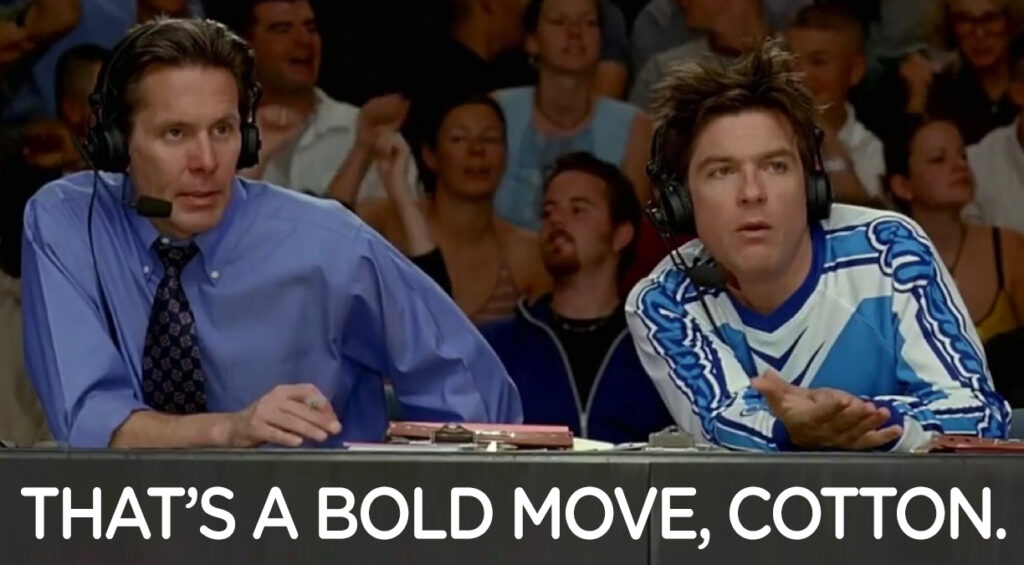Since our name is Stealth, you shouldn’t be surprised we’re always looking for under-the-radar-ways ways to elevate client results. Sometimes that happens figuratively through high-performing digital media strategy, eye-popping packaging or building a brand from scratch.
And sometimes, that happens literally with jaw-dropping drone footage.
But it takes more to capture those stunning aerial views than taking a drone off the shelf and giving it a whirl. Every frame requires a lot of planning, preparation and — yes — paperwork.
Our resident videographer (and drone pilot) Jeff Schaeffer gave us the inside scoop.
License to Thrill
Believe it or not, you need to be certified by the FAA to fly a drone for business purposes. And, similar to a driver’s license, you need to be recertified every two years.
How do you get certified in the first place? Well, The Pilot Institute, which accredited Jeff, recommends studying for an hour a day over the course of a month. The lessons culminate in an exam covering:
- Weather conditions
- Safety protocols
- Identifying controlled air space
- Requesting permission to fly in controlled air space
Seems easy enough, right? Well, not quite. Getting certified involves learning the same charts as airplane pilots, so the learning curve is steeper than you’d think!
Close Calls
Nature finds a way… to get in the way. Shoots can be delayed hours (or days) based on clouds, wind, rain.
And even when sky’s nothing but brilliant blue, you might need to ward off the occasional bird.
“We had a close call with a hawk one time that kept trying to attack the drone,” said Jeff. “We had to pause and put red reflective tape on it to scare it off.”
Tech of the Trade
Why is drone footage becoming more common? Well, it can capture panoramic establishing shots.
It can show off the size of a senior living facility.
Pro Tip:
Using an aerial shot for your Google My Business profile makes it easier to find your location.
And it can take you on an aerial tour of a car dealership’s lot.
Beyond that, the cost of entry is getting cheaper. What used to cost thousands of dollars now runs about $300 or $400 for a decent set up, including automatic flying features. In typical Stealth fashion, we invested a little bit more than that.

Practice Makes Perfection
Like any other skill, piloting a drone is “use it or lose it.” New models and features hit the market regularly. And they aren’t fully self-flying (yet, anyway).
Jeff sharpens his skills by following The Pilot Institute on YouTube and a few handles on the ‘gram. He’ll practice those new techniques during the weekend for fun around the St. Louis area. His favorite place to go? Forest Park, of course.
Fun Fact:
The highest you can legally fly a drone is 400 feet.
Permission to Launch
The next time you an awesome aerial shot, just remember how much work and skill was needed to pull it off.
At Stealth, it’s just another day.
Reach out and let’s talk about how we can give your audience a different perception — from a different perspective.
There are all sorts of crazy marketing myths swirling around that might make you question advertising’s effectiveness.
And we have to admit: You can’t believe everything you see on TV or hear on the radio (or read online for that matter).
Pretty ironic coming from a full-service advertising agency, right?
But that shouldn’t keep you from advertising on TV, radio, or anywhere else. So, let’s shine a light on those lies that are hurting your company’s bottom line.

Video Production Is Just Too Darn Expensive
There was a time where we would’ve agreed. Today… well, not so much — and no, it’s not because of AI!
It really comes down to working with a full-service advertising agency (like Stealth Creative).
Here’s why.
We edit, film, and produce commercials in-house whenever possible because this cuts out the middleperson 95% of the time — and that can cut costs in a big way without sacrificing quality at all.
Plus, it turns out your business really can’t afford not to have some sort of video presence for lots of reasons.
“Some of our most memorable spots were also some of our most creative not only in terms on concepting, but working within our clients’ budget.”
-Jeff Schaeffer, Senior Video Producer

Media Buys Cost An Arm and Two Legs
Not so fast.
The truth is, some media buys cost more than others.
For example, in traditional media like television, there exists a finite number of commercial breaks. A limited number of spots to fit a specific amount of time. So yes: it tends to be a bit pricier. There’s no escaping that harsh reality — it’s the (not so) free market in action.
Conversely, digital media buys can cost just pennies per thousands of views! And radio buys can actually be more affordable than you think.
However, budget-sensitive marketing heads realize they need a media strategy if they want a real shot at success. So, what do they do to make the cost more bearable? They try doing it themselves.

We appreciate that “can do” attitude… we just want to caution you.
35% in savings is an absolutely huge number! It could mean literally thousands of dollars — or more! That’s the same as being able to broadcast your commercial or message more often.
By working with Stealth Creative’s media buying team, you can:

Identify your real target audience

Pinpoint where they’re most likely to watch, listen or read

Benefit from the hard-nosed negotiating skills of your buyers

Experience a more collaborative approach between media placement and the spots produced
“The effectiveness of the message can be more important than the out-of-pocket cost alone. Ineffective impressions reaching your audience (even if they cost next to nothing) are not valuable. Agencies have the strategic experience and tools to develop these solutions to recommend the optimal Media Mix and tactical solutions to deliver against your goals.”
-Lisa Smith, Media Director

Proofreading is Overrated
What do an erroneous letter and missing zeros have in common?
They’ve all led to losses in the millions of dollars.
That’s right. Millions.
Take for instance a Yellow Pages ad (remember those?) from 1988. Banner Travel Agency wanted to promote their exotic travel packages. Someone at Pacific Bell swapped the “x” for an “r” and changed the message completely.
Proofing Cost: $10 million
Then there’s the fiasco involving Alitalia Airlines in 2006. They wanted to promote flights to Cyprus for $3,900. What they actually promoted was flights for $39. Who could pass that deal up? Answer: no one, which led to a nosedive in profitability.
Proofing Cost: $7 million
So, yes. Details matter quite a bit. And when you hire an agency, every piece of work gets read by multiple people before you lay eyes on it — proof that proofreading is worth it.
“Few things can sour your audience’s perception faster than an obvious typo. It makes them question your company’s professionalism.”
-Jeff Ryals, Creative Director

Your Business Should Be On Every Social Media Platform Ever
We won’t dispute the effectiveness of social media. That’s why Stealth Creative has a team of social media specialists!
Sure, your business could create a {insert newest social media platform here} profile. But do you really need to?
Let’s think about it, shall we?

Time:
The more platforms you’re on, the more:
• Content you need to create
• Posts you need to schedule
• Comments you’ll need to monitor

Commitment:
Creating a profile implies you’re going to be active and engaged. If you’re not up to the challenge, your image will potentially look unprofessional.

Relevancy:
A lawn service company should focus their efforts on Nextdoor instead of LinkedIn.
“Now more than ever, it’s important to be where your audience is. Social media is a very saturated place, so you want to make sure you stand out against the competition with content that your target market will resonate with. The more focused you are on the profiles you’re utilizing, the higher the likely quality of the content. Don’t spread yourself too thin – especially if your effort is being used on a platform your audience doesn’t frequent!”
-Kirsten Hackett, Social Media Director

My Company is Too Small to Hire an Agency
This is the myth we want to banish more than any other.
Why? Because in business, as in life, it’s not where you start but where you finish.
Let’s face it: Most companies aren’t an overnight success. They spend months, maybe years, building an audience and carving out a niche, slow but steady.
Then, whether through a website redesign that emphasizes user experience, a breakthrough idea for a commercial or one savvy media strategy, they captured the market’s attention — and odds are an advertising agency helped somehow.
“Smart, strategic marketing can be the great equalizer — and it’s not reserved for household brands. If you’re hungry for growth, it can only help to get input from people whose career is helping businesses become more successful.”
-Dan O’Saben, Owner
It’s a Fact: We’re Ready to Market YOUR Company
And Stealth’s advertising case studies prove that we can make a difference for clients.

Brian Reinhardt
Brian Reinhardt is a Senior Copywriter at Stealth Creative whose first unpublished story was penned at the age of eight. Yes, it involved hoverboards, lasers and robots. His days are filled with researching, content creation and SEO strategy. His nights are spent with family, reading and managing too many fantasy sports teams. Nine is his favorite number.
The agriculture sector across the U.S. can be described as anemic at best thanks to the muddled political world that anyone working in Ag is well versed in. China used to be the No. 1 buyer of commercially grown soybeans in the U.S.; however, that has changed during the last couple years with a tariff-riddled trade war occurring between the two countries.
But, that doesn’t mean there isn’t opportunity for effective marketing. Let’s dive into the current environment before taking a peek at how you can put digital, social media and video marketing to use to promote and feature your grain marketers.
A Volatile Political Environment
Put simply, President Trump and his administration promised on the 2016 campaign trail to hold China accountable for their trade practices. Just last week the White House identified China as a “currency manipulator,” which has been argued by economic analysts on both sides of the coin. The reality is that China is not a direct currency manipulator, but they don’t play by the same rules because they have the demand pull on their side.
The U.S. had mastered the supply push of soybeans to China from both the Pacific Northwest and the Gulf of Mexico until the two countries started slapping tariffs on each other. At first, it sounded like just political rhetoric, but to Trump’s credit, he has dug in and continued to escalate tariffs on imports from China to maximize pressure on the communist country.
China has seen their economy slowdown from these tactics among the current administration, but China tends to strategize over the long-term outlook and is most likely waiting to see how the 2020 elections turn out before proceeding one way or the other.
A Bearish Soybean Outlook
U.S. steel mills were printing money due to the new barrier of entry of Chinese metal until March, when things took a turn for the worse. Exports are what suffer (e.g., soybeans). The only hope for life in the soybean market rests on poor growing conditions or the off chance that China comes back to the table and buys U.S. origin soybeans.
The bad news is the Midwest experienced a wet spring where acreage that usually gets planted with corn was oversaturated, and farmers ended up planting soybeans instead. Not to mention there will be an estimated 1.05 billion (yes, with a “b”) bushel surplus across the United States before soybean harvest starts this year in October.
All of the above supply/demand scenarios make it awfully hard to get bullish soybeans for the next couple years. The good news is the Trump administration has pledged and delivered monetary relief for rural farmers who elected him into office in the first place.
In other words, prices are bad, but the government is cutting a check so life can go on as usual for those making a living off of the land. I’m still not seeing shiny new combines being driven off the lot of the John Deere dealership or land being bought up by producers of every size. Today’s environment feels like 1,000-acre farmers are making it ok, but the 5,000-plus-acre farmers are expanding operations slowly. All signs point to another strong soybean crop again this year with timely summer rains keeping prices depressed.
It appears Agriculture will have to remain in wait-and-see mode and battle with the cards they’ve been dealt as they always have. Large commercial exporters like ADM, BUNGE, CARGILL and LDC are not profitable in the current environment as grain divisions keep weighing down the balance sheets.
The overall outlook is that the industry will continue to constrict despite massive corporate tax cuts being awarded to Ag companies; all that did was allocate money to a rainy-day fund for corporations. Those working in Agriculture will continue to be told to do more for the same amount of money, or find a new career.
The Mississippi River and railroads in the northern plains are ready to get back to business as usual, but the whole value chain appears paralyzed, wearing a lot of temporary Band-Aids. During the next five years, the two major threats to Agriculture will be global warming, creating extreme weather patterns for growing conditions, as well as trade relations with China.

Marketing Your Grain Marketers
Yes, the market is volatile, and recent quarterly earning reports – among publicly traded companies at least – point to more consolidation in the industry. In other words, we should see more company mergers, organizational centralization and cost cutting among major players in the industry.
Keep in mind there is opportunity in that shift.
Farmers will continue to try and eliminate risk amidst the volatility. Grain companies are becoming more vocal with daily market recaps before and after daily trading sessions to establish credibility and provide advice for producers.
Eventually, farmers will sign up record amounts of production towards specialty marketing programs that establish floors and ceilings on yearly prices. Every grain company calls these marketing programs something different. Bunge called it the Alliance Advantage Program; Consolidated Grain and Barge called it their Equalizer family of products. They all take risk off the table.
And all of these major players have invested significant amounts of money training grain marketing specialists on the right marketing plan for each producer. Market factors, farm size, production risk and cash flow can steer a grain marketing specialist towards a specific type of marketing contract each year instead of simply holding town hall meetings every spring and summer across the Midwest to establish credibility.
In fact, the days of the vice president of your grain company spending two weeks holding town hall meetings discussing S&D’s from Fargo, ND, to Lettsworth, LA, are over. Ok, maybe you still have a handful of in-person potlucks with your top customers, but why not work smarter – not harder – by advertising your top marketing specialists?
In a very disciplined manner, you can coordinate a digital and social media marketing plan that drives farmers towards your company and experts. Setting up monthly spend budgets and targeting the right geographic areas stop costs from getting out of control and put less strain on your employees.
Let’s say you have a grain marketing specialist based out of West Memphis, AR, who covers northern Mississippi to Cape Girardeau, IL. Digital and social media marketing requires less in-person attention, and allows you to cover more ground for the same price as paying for monthly travel and entertainment.
If you still had money in the budget, you could supplement digital marketing and social media campaigns with a direct mail campaign that has the same look and feel, and drives the messaging home through multiple media.
You could also create a professional video of each grain marketing specialist that links to a landing page with a form fill to schedule an appointment to learn more.
Interested in learning more about how to put your marketing budget to the best use? Reach out today; we’d love to chat with you more to understand how we can help you do just that.
Did you know that 96% of employees who are happy with their benefits are more likely to be satisfied with their jobs?
So, how do you ensure employees not only know which benefits their employer is offering, but also understand those benefits to make an informed decision about their health and voluntary benefits selection?
As you gear up for your clients’ – or your own employees’ – fourth quarter open enrollment, here’s a few things to keep in mind:
1. Communicate, communicate, communicate.
And then when you think you’ve communicated too much, communicate again! Remember the Rule of Seven: People need to see or hear your message at least seven times before they take action. And this becomes even more important with benefits communications, when education is crucial.
2. Change it up!
When you’re communicating, change up the way you share your message. Don’t assume everyone will see the table tent on the lunch table or the poster in the hallway. Use email, social media, the intranet, instant messaging, desk drops (yes, the old-fashioned paper kind), direct mailers to the home to engage the spouse, group meetings, manager meetings, one-on-one meetings – and more! The sky’s the limit. Just make sure you change up your media.
3.Mind your audience.
Are you talking to a Baby Boomer? A Gen Xer? A Millennial? Or maybe a Gen Zer? Each is going to need different info – and each will react to your messages differently. It’s imperative to vary your messaging within your media to hit each audience.
4. Who ya gonna call?
No, not Ghostbusters! This time, it’s needs to be your company’s benefits expert: Someone in HR, your broker, the president of your company, etc. Determine who can answer employee questions about their benefit package – and do it in a timely manner. Employees need to know they have someone they can turn to with their questions before open enrollment.
5. This way or that?
Think about how employees would be most inclined to participate in open enrollment. With a dedicated benefits expert on hand to help and answer questions? With their spouse at their side to discuss? Think about how you would want to enroll, and what would make the process seamless and smooth for you. Then consider how you can make it just as easy for employees.
6. How'd we do?
Enrollment isn’t finished when the applications are all submitted. Not by a long stretch. It’s time to follow-up with surveys for all! That includes not only the employees who enrolled, but also the HR and benefits staff, managers, marketers, senior leadership and anyone else who was involved in putting the program and process together.
By putting some extra thought into the planning process and marketing efforts, you can pull off the best open enrollment you’ve had to date!
Want to talk more about how best to communicate, promote, educate and market before, during and after open enrollment? Reach out today – we’d love to chat more.
As always stay tuned until the next time we go Off the Radar.
“It’s time to ‘gobble’ up savings with these great Black Friday deals! You don’t want to be caught ‘winging’ it this Thanksgiving!”
We’ve already covered (and you’ve already read) why video content is a crucial component of any worthwhile marketing plan.
So now that you’re taking the plunge into making your own video, or hiring an agency that can, you need to recognize that new eyes will be watching your company.
Let’s talk about how to make your videos perform better.
What does your customer base care about?
That’s the most important question to ask before creating your script, storyboard or budget.
Why?
Understanding what matters to your customers will influence all the above. You don’t want to waste time and energy on videos that won’t convert.
So, how do you find out what interests your audience or what information they need?
A good first source would be your website’s analytics to see which pages are visited most often (obviously).
You could also tap into social media and read topics on forums dedicated to your industry.
Even better, you could engage fans and followers directly on your social media channels by asking them to answer a poll. Give them a wide range of topics to choose from and go with the one people seem drawn to the most — either in number or sentiment.
How long should your video be?
Answer: It depends. And no, we’re not trying to dodge the question.
The fact is, people are willing to invest different amounts of time depending on where they are in their decision making.
Vidyard has a great breakdown of what time target you should be aiming for based on this factor. The whole thing is worth a read, but if you’re crunched for time (see what we did there?):
- Top-of-funnel (awareness): 30-90 seconds
- Mid-funnel (how-tos): 2-10 minutes
- End-of-funnel (demonstrations or sales presentations) 5-10 minutes
Think of it this way: People will invest more time researching the closer they are to spending their hard-earned money.
So, tease them with something short and memorable when they’re just beginning to browse — and spend more time convincing them when they’re about to buy.
The shape of the screen (and frame) matters
Here’s something most people don’t give a second thought to: The shape of the video they watch — or make.
When it comes to viewing completions, interactions and overall performance – the stats that matter – square vs. landscape presentation matters. A lot.
For instance, square videos perform better (i.e. higher completion rates, views and engagement) on mobile.
Why?
They take up way more screen-estate. (That’s a word, right?) 78% more to be precise.
It’s harder to avoid something if the thing in question is bigger.
Conversely, landscape videos perform better on desktop or laptop.
Most people pull the purchasing trigger from their desktop. So, it’s reasonable to infer that landscape videos would be best suited on a product page and square videos on a landing page (or Facebook/TikTok/Instagram).
What’s Your Hook?
Social media sharing is certainly one of the most affordable ways to get more video views.
But regardless of how people eventually view your cinematic skills, one thing is constant: That first frame counts more than anything.
We’re not talking about the first second of the video (although that’s important); we’re talking about the exact frame you choose as a thumbnail image to give a one-one-thousandth-of-a-second impression.
Choose the most interesting or vivid millisecond of your video and make that the image to reel in your viewers.
And while text overlays are generally – but not always—advised, try associating a provocative question or tantalizing benefit as a super (the text that overlays an image or video).
You know people should watch your video. Tell them why right off the bat.
Align your CTAs
Here’s a counter-intuitive business statement: Selling isn’t always everything.
At least directly.
Most assume (rightly so) that every video should end with a prompt to buy, call or sign up.
But here’s the thing: Most people will do that without being told to if they like what they see.
Sometimes, every once in a while, it’s okay to ask them to do something different.
Maybe you want more social visibility; so ask for a like or comment.
Or, maybe you just want your audience to be more creative. You’re simply asking them to use their imagination… preferably with your product.
Whatever you ask them to do, make sure it’s appropriate given their likely position on their buying journey.
You don’t want to be too soft when the deal is all but sealed, but you also don’t want to come on too strong too early in the process.
That’s a Wrap
And there you have it: A smattering of things to remember when you’re creating your first (or fifteenth) video to attract and retain more customers.
Still deciding what type of video makes most sense for your marketing goals?
Check out our reel for inspiration and reach out to discuss how Stealth Creative can help.
How much do we love watching videos? A lot. So much that videos comprise 82% of all internet traffic! No wonder that 91% of businesses use video as part of their advertising strategy.
So if you’re on the fence about incorporating this medium into your marketing mix (or need some ammo to increase your budget), here are six important reasons why you should use video to your advantage:
1. Reinforce brand awareness
Video is arguably the best way to demonstrate your company’s unique selling point (USP). Why? It invokes our visual and auditory senses, which in turn makes the message memorable.
But here we should stress that not every message needs to — or should — center on selling. Especially if your company is new or relatively unknown. In this case, you should focus on increasing your brand’s awareness.
Think about it: When you’re in the market for any kind of product or service, you’re probably more likely to choose a brand you’ve heard of or are familiar with (all things being equal). You’re effectively eliminating yourself from the consideration set if no one knows your company exists.
2. Educate and attract customers
An overwhelming majority (89%) of consumers want more videos from brands! Give them what they want. And while you’re at it, make your videos helpful in the form of how-tos, demonstrations, tips, tricks and more.
Doing so can:
-
- Build trust
- Increase purchase likelihood
- Improve dwell time on websites
It can influence buying decisions, demonstrate product information and so much more. If your audience enjoys the video ads, this can increase purchase intent by 97% and brand association by 139%.
3. Recruit employees
Most job postings list little more than essential details like salary, benefits and desired experience. But you can make your company stand out by showcasing what working there is like with video: 3-D tours, quick introductions from the owner, b-roll of team building activities. Well-crafted internal communication allows you to give a great first impression to potential teammates and convey the passion that drives your company.
If you need a little inspiration, check out what Zendesk did.
4. Improve your SEO rankings
SEO is an ever-evolving labyrinth of algorithmic updates. But what if we told you that video seems to be a constant among those sites that perform well in organic search?
It’s true! Consider:
-
- Google uses video thumbnails in 26% of Search Engine Results Pages (SERPs)
- Video content generates a 41% higher Click Through Rate (CTR) than text results
- Search results with video generated 157% more organic traffic
Source: AIOSEO
This begs the big question: How come?
Well, pages with video typically have:
-
- Longer time on site
- Lower bounce rates
- More conversions
In Google’s eyes, pages with this performance are generally viewed as more valuable or relating to a searcher’s intent. And as such, those pages are given a boost.
5. Attract mobile visitors with less written content
If a picture’s worth 1,000 words, what about video? Well, it’s been estimated that one minute of video is worth roughly 1.8 million words.
That’s an interesting thought experiment, but what does it mean? For one, it reinforces the adage of “Show, don’t tell.” Visuals do the explaining, not tomes of text. For two, it underscores the importance of embracing media consumption habits. 70% of all videos are watched on smartphones, which, believe it or not, is a higher percentage than smart TVs! In other words, smaller screens require information to be conveyed in different formats.
6. Boosts Social Media Performance
One of the most sure-fire ways to increase social engagement? You guessed it: video.
-
- 50% of Instagram users have visited a website to buy a product or service after seeing a Story
- Posts on X with a video receive 10X more engagement compared to text-only posts
- 74% of Gen-Zers do more research about a company after seeing a Dynamic Showcase Ad on TikTok
Source: Sprout Social
The Camera is Mightier Than the Sword
As a full-service advertising agency with comprehensive in-house video capabilities, Stealth Creative can help with any and every facet of video marketing, starting with strategy, all the way to creative execution, distribution and sales monitoring.
You might also want to check out our article on 5 Surefire Ways to Make Your Video Perform, and then contact us to see how we can transform your marketing plan.
Your business might be drawn to the allure of promoting your services through TV commercials. But there’s probably one thing holding you back: the budget.
You can still push forward. There are plenty of ways to create an impressive commercial on a budget.
If you’re interested in creating a broadcast commercial for your company, but don’t want to break the bank, listen up—the main factors associated with commercial costs are preparation and production.
Below are some helpful steps and guidelines to help affordably broadcast your message to the masses.
“My product sells itself. I don’t need video.”
So many companies fall into this trap of thinking. While it may be true that you have a killer product or service, video should still be an essential component in your marketing strategy.
Videos are effective and versatile because they can reach customers at all stages of the buying decision process:
- Awareness during the discovery phase
- Product reviews during the consideration
- Post-purchase support in the form of how-to or repair instructions
With online video accounting for nearly 75% of mobile traffic, the importance of this marketing component can’t be ignored.
In fact, 91% of businesses use video. So, will you invest in this strategy or fall behind your competitors?
What kind of video is the best fit for your company?
The most commonly used e-commerce videos are:
- Explainer
- Product
- Instructional
- Testimonial
- Promotion
- Lifestyle
Explainer
An explainer video is just a quick introduction to your company. Think of it as your elevator speech. Something adaptable and memorable. Not only can you upload it for the public, you can also bring it along to meetings or your next pitch.
Sure, you could rattle off a quick description, or you can really wow your audience and give them a lasting visual impression. The key takeaway for the audience should be your company’s value — how can you help them? Reiterate your audience’s problem and show how you can solve it.
Prepare your explainer video with a concise script and remember to speak to your audience. Is this for the public to build awareness? Then simplify your language and adopt a conversational tone. Is this for a private presentation to a CEO? Speak formally and keep it informative.
Finally, don’t forget the call-to-action. What do you want the viewer to do? Call your office or download a whitepaper? Make the request relevant for your company.
You can see each of these tenets brought to life in the explainer video we produced for our client, Tolam Earth.
Product
Product videos are extremely useful for customers because it gives them the chance to interact with your product from different angles. Effective product videos follow a before and after theme. For example, we know how to use most common cleaning products, but in a product video, you can show the results of those products.
We did something similar for RepelWell on their social media channels, which you can check out here. If nothing else, it proves you don’t need a big budget to make this part of your marketing mix.
Instructional
Instructional videos should be more in-depth than the average product video. Here, you can go into detail about how to operate your product or service. These videos build trust, loyalty and enforce your credibility.
Troubleshooting videos also fall under this category. By developing a series of how-tos or tutorials, you provide visual support whenever its needed, which goes a long way in turning one-time buyers into lifetime customers.
Our client, Sparklight Business, wanted to inform business owners about the rising threat of cybersecurity attacks. Stealth Creative wrote and produced this video informing companies what they can do to protect their data.
Testimonial
Ah, yes, the power of word of mouth. Close to 95% of consumers read online reviews before purchasing, so capture those positive comments on video! A good video personality mixed with the benefits is the best formula for a testimonial video.
We produced this video capturing why our client, Sparklight Business, proves vital for their client, River Sober Living.
Promotion
Promotion videos showcase your latest specials and sales — and social media loves promotion videos. They’re quick, attention-grabbing and most importantly: addictive. In fact, people spend 50% of their time on Facebook and Instagram watching videos! So, why not promote your sale or event?
Just look at this video Stealth produced for a business internet and phone bundle. Not only did we weave a concept throughout, the payoff resonated with the intended audience.
Results? One of the best-performing campaigns our client had experienced in quite some time!
Lifestyle
Lifestyle videos focus on branding. Instead of capturing one item, this is a way to distill the true essence of your brand. Forget product features, benefits and selling. Lifestyle videos are all about narrative and emotion. They tap into our natural attraction to storytelling — translating into human connections from your product.
When you watch the story we tell for Friendship Village, you’ll practically feel what it’s like to live there.
Which Video Type Makes Most Sense for Your Business?
Contact Stealth Creative and we’ll take care of everything from ideation to production.
Stealth is excited to announce the addition of a new service for our clients. Over the summer, we designed and installed a new in-house video suite.
Video is the direction online content is going. Today’s audiences demand video. It is a crucial marketing tool. Having an in-house suite allows us to partner with our clients throughout the entire production process – and that means we can get things out more quickly and maintain high quality.